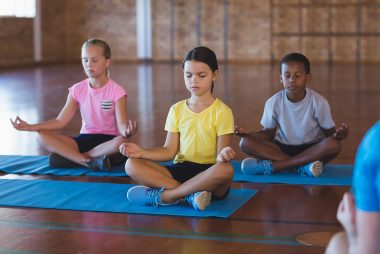Yoga as Trauma Treatment for Children
Though difficult to know exactly how many cases of child abuse and neglect there are every year in the United States, about 3 million reports are made to Child Protective Services that represent 5 million children. Even those high numbers are thought to be underestimates because when adults are asked about childhood abuse or neglect, 30% report physical abuse in childhood, 20% report sexual abuse in childhood, and 15% reports some type of psychological abuse (Trauma & Dissociation in Children, 2007). And these numbers just continue to go up. In 2018, 4.3 million cases were reported to CPS effecting 7.8 million children (U.S. Department of Health & Human Services, Administration for Children and Families, Administration on Children, Youth and Families, Children’s Bureau, 2018). Either more abuse is occurring to children (along with more under-reporting) or there is no drastic increase at all, yet more of those children who did not report are reporting or CPS is being afforded more resources to handle more intake. I would like to think it is the ladder answer, but we will never truly know. Child abuse and trauma can be hard to detect and/or prove and is grossly under-reported. As Dr. Van der Kolk said, “We know that child abuse and neglect is the single largest public health issue facing our nation, the most expensive and devastating (Trauma & Dissociation in Children, 2007).
If this problem has been and still is this extensive, why is there not more diligent coverage on it in the media to raise awareness to the masses and a more extensive push for programs and procedures within daycare, schools, and the medical field? There are most certainly some great advocates and programs in place nation-wide, like the CDC and what they support on a yearly basis. The CDC works extensively to promote communities, practitioners, and teachers continued knowledge on the topic and supports prevention of adverse childhood experiences (ACEs) across the nation. They facilitate many states in collecting ACE-specific data that aids in future resource targeting and facilitate releasing evidence-based strategies for the consumption and use by local health departments, schools, and communities (CDC, 2019).
Seeing that childhood trauma and abuse does not seem to be decreasing and the under-reporting is still prevalent, I think it is dyer that this nation put into place more efforts to detecting and the treatment of trauma and abuse with children. A treatment and potential stimulation for more disclosures of trauma or abuse is yoga. It may sound rather silly at first but when one reads up on the positive outcomes of yoga on adults and children who have experienced extensive trauma either as an adult or as far back as childhood, it is hard to find a reason not to support the idea. There is limited empirical data on the positive effects yoga has on traumatized children, but one great example was the study conducted on children in Haiti who survived an earthquake and were ultimately left orphaned. Many of these children lost one or two parents and experienced hunger and violence. They were given yoga for 8 weeks, consisting of breathing techniques, postures, and meditation, with positive results: the children who received yoga saw reductions in trauma-related symptoms (Culver & Whetten & Boyd & O’Donnell, 2015).
Yoga is a program that typically consists of a combination of breath practices, stretches or postures, and meditation. Bessel Van der Kolk who wrote the book The Body Keeps the Score: Brain, Mind, and Body in the Healing of Trauma was a huge advocate for yoga as a treatment for trauma. He treated many, many patients who he had participate in routine yoga – specifically focusing on breath and postures to become more in tune with themselves– and many of these patients, as a result of yoga, were able to come to terms with what traumatized them and the realization that they were not at fault. He also conducted actual studies on the physiological affects yoga had on trauma patients. He found that yoga significantly improved arousal problems in PTSD patients and drastically improved their relationships to their own bodies (2015). This is huge in the realm of trauma because being able to recognize how and why you react to certain triggers allows you to begin the healing process and control how you react moving forward. Since trauma effects one’s entire nervous system, it is critical for treatment to engage the entire organism, body, mind, and brain, which yoga can do (Van der Kolk, 2015).
Yoga is something that could be implemented in daycare and schools at a relatively low cost. The potential results that teaching yoga to children could accomplish would be well worth any of the resources it took to mandate it. Now, there would most likely be a minimum age requirement since incredibly young children would not have the attention span to participate. Through more thorough research that could be addressed. The Haiti study mentioned herein started with a 7-year age group, so that could be a starting point. I just see the opportunity for this small step to bring children more in tune with their bodies and minds and therefore could lead to them to reporting more often then what we are seeing now.
References:
(2007). Trauma & Dissociation in Children [Video file]. Cavalcade Productions. Retrieved May 31, 2020, from Kanopy.
Centers for Disease Control and Prevention. (2019). Identifying, Preventing, and Treating Childhood Trauma. Retrieved from https://www.cdc.gov/washington/testimony/2019/t20190711.htm.
Kathryn A. Culver, Kathryn Whetten, David L. Boyd, and Karen O’Donnell.The Journal of Alternative and Complementary Medicine.Sep 2015.539-545.http://doi.org.ezproxy.bu.edu/10.1089/acm.2015.0017
U.S. Department of Health & Human Services, Administration for Children and Families, Administration on Children, Youth and Families, Children’s Bureau. (2020). Child Maltreatment 2018. Available from https://www.acf.hhs.gov/cb/research-data-technology /statistics-research/child-maltreatment.
Van der Kolk, B., (2015). The Body Keeps the Score, Brain, Mind, and Body in the Healing of Trauma. Penguin Books.
